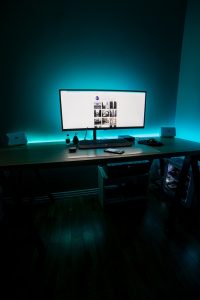What are Tips That Will Make you Buy a Desktop?

Here are some tips that can help you make an informed decision when buying a desktop computer:
- Purpose: Consider the purpose of your desktop computer. Are you buying it for gaming, office work, content creation, or general web browsing? Different purposes may require different specifications, so understanding your needs will help you choose the right desktop.
- Processor (CPU): The processor is the brain of your desktop. Look for a processor with sufficient processing power for your needs. Intel Core i5 or i7, or AMD Ryzen 5 or 7 are popular choices for most general computing tasks, while higher-end processors like Intel Core i9 or AMD Ryzen 9 are ideal for gaming or content creation.
- RAM (Memory): Random Access Memory (RAM) affects the speed and performance of your desktop. Aim for at least 8GB of RAM for basic tasks, but consider 16GB or more for gaming, content creation, or multitasking.
- Storage: Consider the storage options available. Solid State Drives (SSDs) are faster and more reliable compared to traditional Hard Disk Drives (HDDs), but they can be more expensive. Look for a desktop with ample storage capacity for your needs.
- Graphics Card (GPU): If you plan to use your desktop for gaming, video editing, or other graphics-intensive tasks, a dedicated graphics card is essential. NVIDIA GeForce and AMD Radeon are popular graphics card brands, but do your research to find the right GPU for your needs.
- Connectivity: Check the available ports and connectivity options on the desktop. USB ports, audio jacks, card readers, and other connectivity options are important for connecting peripherals and devices.
- Operating System (OS): Decide on the operating system you prefer, such as Windows, macOS, or Linux, and choose a desktop that comes with the appropriate OS or is compatible with it.
- Budget: Set a budget and stick to it. Desktop computers come in a wide range of prices, so consider your budget and prioritize your needs to get the best value for your money.
- Brand and Warranty: Consider reputable brands with good customer reviews and reliable warranties. This ensures that you are investing in a quality desktop that is backed by good customer support and after-sales service.
- Upgradeability: Check if the desktop is easily upgradable in terms of components such as RAM, storage, and graphics card. Upgradability can prolong the lifespan of your desktop and provide flexibility for future needs.
By considering these tips, you can make an informed decision when buying a desktop computer that meets your needs and budget. It’s always a good idea to do thorough research, compare different options, and read reviews to ensure you’re getting the best desktop for your requirements.
Here are some additional details to help you make an informed decision when buying a desktop computer:
- Purpose:
- Gaming: If you’re buying a desktop for gaming, consider the system requirements of the games you plan to play. Look for a desktop with a powerful processor, ample RAM (16GB or more is recommended for gaming), a dedicated graphics card with high performance, and sufficient storage space for your game library.
- Office work: For basic office tasks like word processing, spreadsheet management, and web browsing, a mid-range desktop with a decent processor (such as Intel Core i5 or equivalent), 8GB of RAM, and a moderate amount of storage (256GB SSD or higher) should suffice.
- Content creation: If you plan to use your desktop for tasks like video editing, graphic design, or other content creation work, consider a high-performance desktop with a powerful processor (such as Intel Core i7 or AMD Ryzen 7), at least 16GB or more of RAM, a dedicated graphics card with good rendering capabilities, and ample storage space (512GB SSD or higher) to store large media files.
- Form factor:
- Tower desktops: These are the traditional desktop form factors that typically offer more flexibility in terms of upgradability and customization. They are larger in size and can accommodate multiple components, making them suitable for gaming or content creation.
- All-in-one desktops: These are compact desktops where the computer components are integrated into the monitor. They take up less space and offer a streamlined look, making them ideal for smaller spaces or for those who prefer a minimalist aesthetic.
- Processor (CPU):
- Intel processors: Intel Core i3, i5, i7, and i9 processors are popular choices for desktops, with higher numbers indicating higher performance levels. i5 or i7 processors are generally suitable for most general computing tasks, while i9 processors are high-end and offer top-tier performance.
- AMD processors: AMD Ryzen processors are also popular choices for desktops and offer competitive performance. Ryzen 5, Ryzen 7, and Ryzen 9 processors are commonly used in desktops, with higher numbers indicating higher performance levels.
- RAM (Memory):
- 8GB of RAM is generally considered the minimum for most general computing tasks. However, for gaming, content creation, or multitasking, consider 16GB or more for smoother performance.
- Look for desktops that offer upgradeable RAM slots, so you can easily expand your RAM in the future if needed.
- Storage:
- Solid State Drives (SSDs) offer faster boot times, quicker application loading, and improved overall system performance compared to traditional Hard Disk Drives (HDDs). Consider a desktop with an SSD as your primary storage for faster and more efficient computing experience.
- HDDs, on the other hand, offer larger storage capacities at a more affordable price per GB, making them suitable for storing large media files, such as videos, photos, and games.
- Consider a desktop with multiple storage options, such as a combination of SSD and HDD, to strike a balance between performance and storage capacity.
- Graphics Card (GPU):
- A dedicated graphics card is crucial for gaming, video editing, and other graphics-intensive tasks. Look for desktops with dedicated graphics cards from reputable brands such as NVIDIA or AMD, with higher VRAM (Video RAM) for better performance.
- Research the recommended system requirements of the software or games you plan to use to determine the appropriate graphics card for your needs.
- Connectivity:
- Check the available ports and connectivity options on the desktop, such as USB ports (USB 3.0 or higher for faster data transfer), audio jacks, card readers, and video output options (such as HDMI, Display



